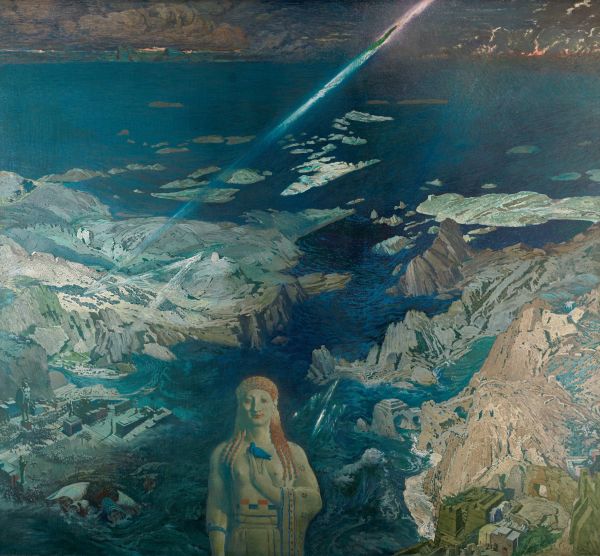|
|
Terror Antiquus. 1908

Bakst Léon,
Oil on сanvas
250 x 270
State Russian Museum
Annotation
In 1907, Léon Bakst visited Greece in the company of Valentin Serov, sketching the country’s ancient monuments and Mediterranean nature and reading the works of her ancient philosophers and writers. This helped to form an image of Greece and Greek culture in his imagination, one both concrete and simultaneously abstract. This duality can be seen in Terror Antiquus, in which the artist uses symbols to express the apocalyptic nature of the modern age. He depicts the destruction of an ancient city and its inhabitants. Bakst scrupulously reproduces a number of ancient edifices — the Lion Gate in Mycenæ, the ruins of the palace at Tiryns, and the Athenian Acropolis.
The natural landscape in the picture is a generalisation and also reflects Bakst’s study of Hellenic geography. The image of the Archaic kore presiding over the chaos and personifying the inexorable force of human fate is equally concrete and just as abstract.
Although the critics found many faults in Terror Antiquus, Bakst’s painting enjoyed great success at the Salon d’Automne in Paris. It was awarded a gold medal at the Exposition Universelle in Brussels in 1910.
Author's Biography
Bakst Léon
Bakst, Leon (Lev Samoilovich)
1866, Hrodno - 1924, Paris
Painter, graphic artist, theatrical designer. Studied at the Imperial Academy of Arts (1883-87) and the Atelier dc Jean Louis Gerome and Academic de Rodolphe Julian in Paris (1893-96). Taught at the Elizaveta Zwantseva School of Drawing and Painting in St Petersburg (1906-09). Member of the Society of Russian Waterecolourists (1891-1907), World of Art (1899-1903, 1906, 1913) and the Union of Russian Artists (1903-1910). Life member of the Salon d''''Automne (from 1906). Academician (1914). Contributed to many exhibitions of theatrical design and one-man shows. Designed sets and costumes for the Mariinsky Theatre and Alexandrinsky Theatre in St Petersburg, Paris Opera and theatres in London and New York. Leading designers of Sergei Diaghilev''''s Ballets Russes (from 1909) and the ballet companies of Anna Pavlova and Ida Rubinstein. Emigrated to Paris (1909).

